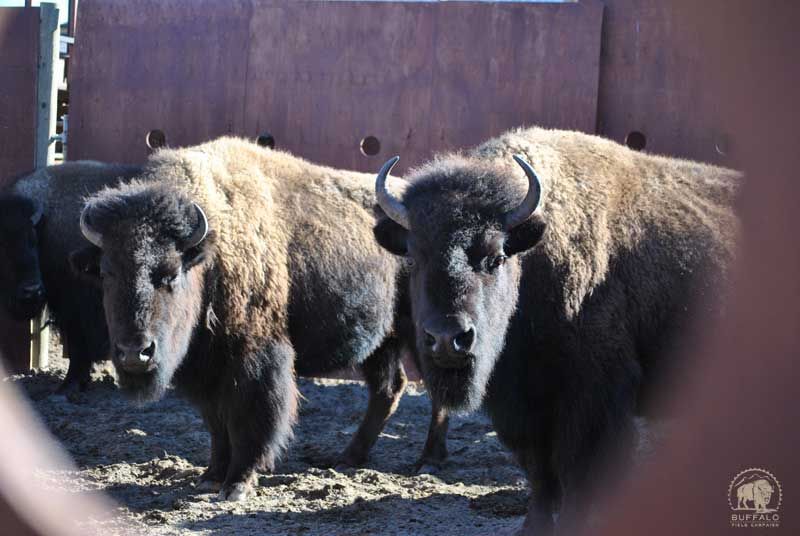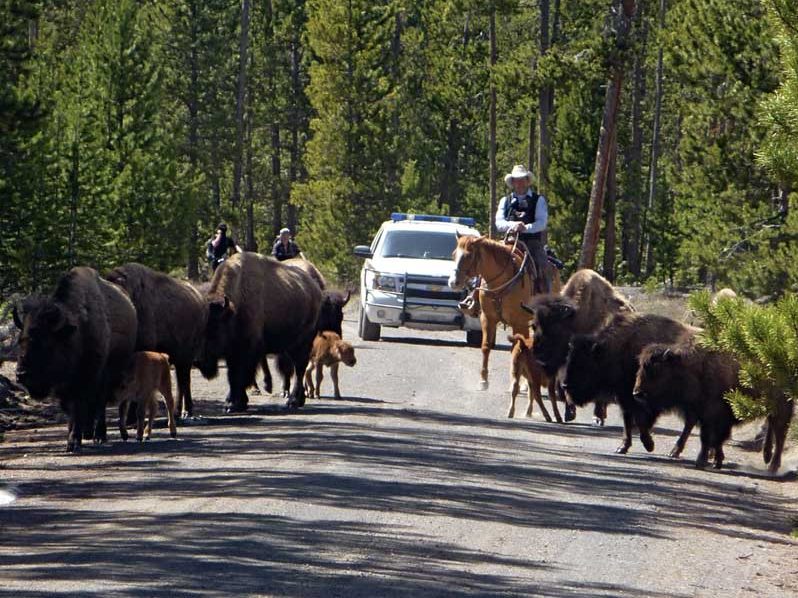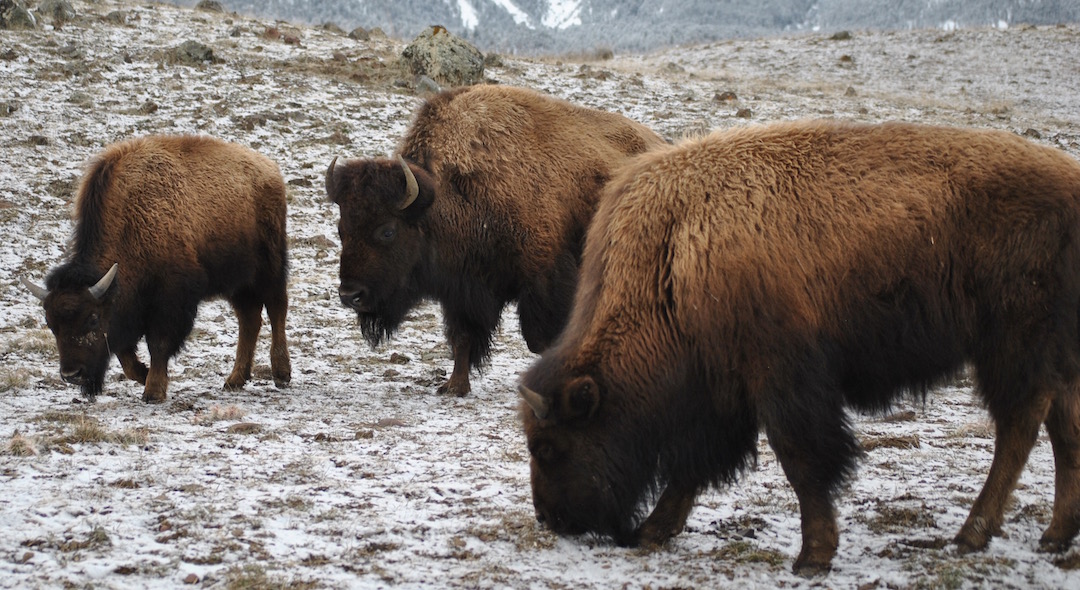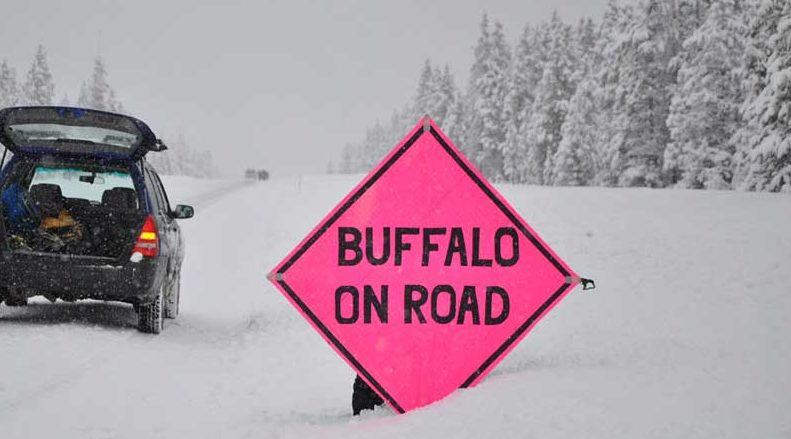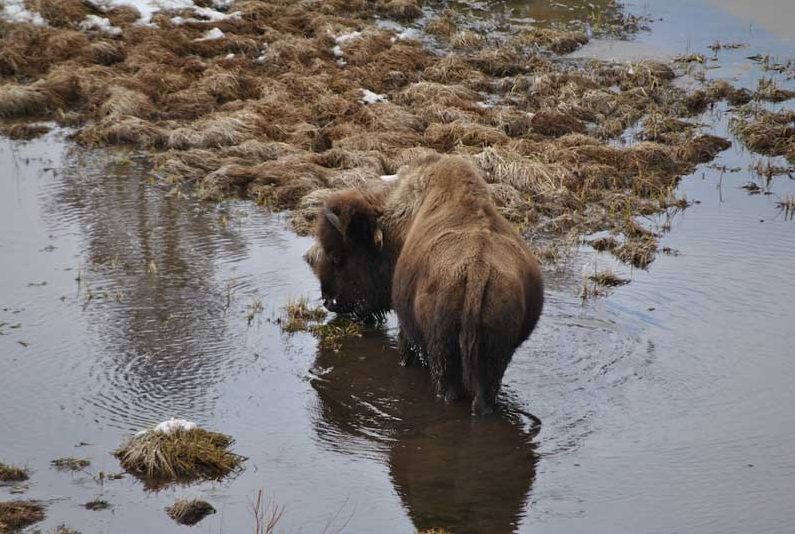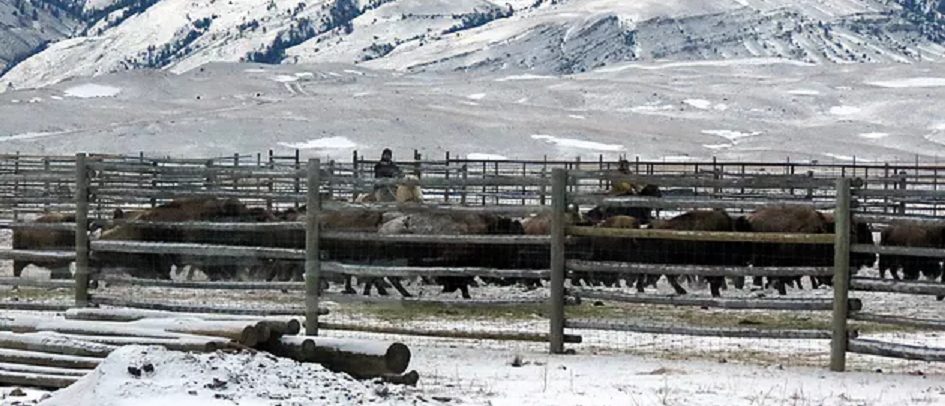
Yellowstone Buffaloes’ Last Stand
Featured image by David Mattson
by Louisa Willcox / Grizzly Times
Last Tuesday, in the shadow of Yellowstone’s Electric Peak, I watched National Park Service employees herd, prod, shock, immobilize, poke, and corral bison that had only shortly before spent their lives roaming wild. That day, 45 animals were shipped for slaughter and 62 “processed” in preparation for being sent to death next week. So far this winter, almost 1,000 out of a total of roughly 5,500 bison have been sentenced to death by government agents or dispatched by hunters.
The killing of Yellowstone’s buffalo is far from over. The carnage is escalating as winter drags on and buffalo, desperate for food, leave Yellowstone Park for lower elevation grasslands north in Montana’s Gardiner basin. Hundreds more buffalo could be sent to slaughter by the time spring green-up occurs, when buffalo return to graze in the protected core of the Park. A total of 1,400 or more Yellowstone bison could be killed, not including the animals (possibly hundreds) that otherwise do not survive harsh late-winter conditions.
It is important to note that these are not just any bison, but members of the largest free-ranging bison herd in the country, and the most genetically pure of any left in the world. In most other places buffalo have been interbred with domestic cattle. Perhaps most importantly, Yellowstone has the only herd left that still serves something akin to the ecological role that it played when Europeans first arrived and 30-88 million bison thundered across the plains of what is now the western United States.
How is it that this harassment and torture of bison is happening inside a national park, which is presumably all about preservation?
The extent to which Park Service personnel work to keep their violence towards buffalo out of the public eye is perhaps emblematic of a conflicted conscience and cognizance that something is morally wrong. But a lawsuit brought last year by journalist Christopher Ketcham and Stephany Seay, Communications Director of the Buffalo Field Campaign, (BFC) requires the agency to now show the media what it is doing. I can say that witnessing the Park Service-administered treatment of buffalo is not for the faint of heart.
With the help of poles and electric cattle prods, bison after bison was forced from a small pen into a hydraulic squeeze chute, where it bucked and thrashed and bellowed, in a crazed panic. Each bison was squeezed so hard inside the metal cage that most finally stopped bucking, at which point a metal bar pinned its head up to the side of the chute. Through the slats in the chute, you could see their tongues hanging out, and their eyes bulging. Their hoarse breathing was audible, even from 20 yards away. Many had blood on their coats as a result of injuries from the horns of other distressed bison—a direct consequence of being stampeded, slammed up against each other, and pushed between pens along a maze of metal-reinforced alleys. Some of the younger bison literally tore their own horns off against the cages and bars. If there is a hell in the bison world, this must be it.
While pinned in the chute, Park technicians drew blood and checked teeth, weighed them, then released them into holding pens.
A few yearling calves escaped the ordeal because the chute was too big to effectively contain and immobilize them. These were waved through. Still, none of the bison we saw will likely escape slaughter.
The chute’s brand name, “The Silencer,” had been deliberately painted over with an inane reminder of the year, “2016-2017,” perhaps in case we journalists were to attempt substituting photos of atrocities perpetrated during previous years for the atrocities perpetrated while we were there.
From a catwalk above the pens, I could see a group of yearling calves, all with smears of blood on their bodies from rubbing up against one calf whose horn had been torn off. They looked up at me in terror and alarm. I was helpless to do anything except bear witness. I felt that these youngsters were owed a profound apology.
In a matter of days, these calves will be gutted, dressed and hung in White’s Meat Processing in Ronan, Montana. According to the federal Humane Methods of Slaughter Act, the process entails literally sending animals to a gas chamber, after which they are “stunned, shackled, hoisted, thrown, cast, or cut.”

Bison Cowboys: Shipping Yellowstone Bison to Slaughter. Note Electric Cattle Prod
The meat will be distributed to Indian people, which is better than most alternatives, but hardly the point. These wild beings, the product of millions of years of evolution, uniquely adapted to the harsh conditions of Yellowstone, and members of a close-knit herd, will be killed for no reason except to placate tough-minded stockmen and their ideologue allies (read: Trump’s core supporters).
As in the case of grizzly bears and wolves, management of buffalo caters primarily to a minority of well-heeled and politically well-connected agriculture interests at the expense of the broader public, who flock to Yellowstone to see these rare and iconic animals in the flesh. More on this later.
There seems to be no regard for the fact that bison have been on this landscape since the Ice Age, or that they survived the worst that the forces of nature could throw at them – except Europeans and our guns. Their ancestors evolved with giant short-faced bears, sabre tooth cats, dire wolves, woolly mammoths and ice-age camels. All these animals are gone now, but a remnant of bison is still with us.
Yellowstone bison are descendants of just 23 animals that had survived the slaughters of the 1800s. All this begs the question: why are we persecuting these animals again? And why is the Park Service, which helped bring them back from the brink, so intimately involved in their deaths?
Atrocities in Yellowstone Park
It baffles me that the National Park Service is leading current efforts to capture and send to slaughter buffalo that are simply poised to roam north into the Gardiner Basin – as bighorn sheep, elk, deer, pronghorn, wolves and bears do. This behavior is natural. Even though buffalo are well-equipped with huge heads for shoveling deep snow to uncover grass, roaming downhill to more clement climes is the path of least resistance when snow is deep, or when thick ice prevents bison from reaching the grass below.
With the Park Service’s help, the state of Montana will probably reach its goal of killing 1,400 Yellowstone’s buffalo. Although the Park Service estimates that forage in Yellowstone could support 5,000-7,000 buffalo, an outdated bison management plan uses an antiquated target of 3,000 animals. Further, a 2000 court-mediated settlement agreement of a lawsuit filed by Montana’s Department of Livestock against the Park Service gives the state and its powerful livestock industry inordinate influence over bison management, even it appears, inside a national park.
It was noteworthy that no one from Montana’s livestock industry or State Department of Livestock participated in the tour I was on. Why bother, when Park Service employees seemed more than happy to do their dirty work and field the tough questions from reporters — despite the fact that this work is antithetical to the Park Service’s mission of protecting natural resources.
Having worked as a wildlife advocate for over 30 years in the political pressure cooker that is Greater Yellowstone, I can only imagine the conversations among Park officials. “Maybe our willingness to kill so many will buy good will from the state in the revision of the bison plan.” Or: “our hands are tied, especially under the new Secretary of Interior Ryan Zinke,” a former Montana Congressman with strong ties to industry. Or: “if we kill 1,400 bison this year, we might buy a reprieve of several years before a similar out-migration of bison would necessitate significant killing again.”
All humans share the unique ability to rationalize activities that feel inherently wrong. I doubt that many of the Park employees engaged in this debacle had imagined that their job description could include sending to death wildlife that they had been entrusted to protect.
Last year, Yellowstone Park proposed shipping some animals that would have been otherwise killed to a quarantine facility on the Fort Peck Indian Reservation in northern Montana. There is presently only one such facility authorized to take Yellowstone bison, located 30 miles north of Yellowstone near the hamlet of Corwin Springs. There, USDA’s Animal Plant Health Inspection Service (APHIS) kills 50% or so of the captive buffalo that test positive for the disease brucellosis—which is the putative cause for the entire capture, containment, and slaughter program. (More on this later).
Over time, the caged sub-population is “cleansed” of the disease, but there is no chance of returning home. Nor will this — or any other method proposed so far — purge the entire population of the disease.
Needless-to-say, the Park’s proposal to send bison to Fort Peck’s facility is stridently opposed by livestock organizations, but supported by some conservationists and Tribes. Two weeks ago, Republican state legislators killed a bill that would have authorized the shipping of Yellowstone buffalo to Fort Peck. There is no doubt that regressives in the livestock industry have the upper hand, and will not make even modest concessions to those who have more altruistic and public-minded values.
Buffalo Management: The Ruse of Cleansing the Land of Disease
You commonly hear that the killing and expensive quarantine of buffalo is to protect cattle from the disease brucellosis, which is carried by buffalo. (Paradoxically, bison originally contracted the disease from European cows). But this rationale turns out to be bogus. Although buffalo do carry brucellosis and could theoretically transmit the disease to cattle, they have never been known to do so in the wild. In fact, there are only a handful of cattle near where the buffalo migrate in winter – and none of these cows are on public lands.
By contrast, elk, which are 25 times more numerous than buffalo and interact with cattle far more often, have transmitted brucellosis to cows on at least 6 documented occasions, most recently in November, 2015 (link). Yet nothing is being done about the elk “problem”, in part because elk are sportmens’ darlings and generate at least $11 million annually in state hunting revenues in Montana. Something deeper, even pathologic, lies beneath disparities between how bison and elk are treated.
If brucellosis were a real problem, the livestock industry would be advocating more consistent policies and taking the elk disease threat seriously. But such is not the case, which suggests that the hype about brucellosis in bison is really cover for something else.
In fact, what we have is a cabal of stockmen, state veterinarians, legislators, and employees of the Board of Livestock using paranoia over “disease ridden” buffalo to perpetuate political control and an archaic, regressive mindset obsessed with dominating the natural world. These bad actors aim at nothing less than keeping the West under their thumb, perpetuating a regime that was instituted under the banner of Manifest Destiny. This despite the fact that the region’s economic and cultural health depends increasingly upon amenities rooted in wildlife and public lands.
Mary Meagher, longtime bison biologist in Yellowstone Park, put it this way: ”Brucellosis is a smoke screen. The real issue is that ranchers do not want bison out on the land.” (link)
In furtherance of their agenda, the livestock industry has adopted the bizarre and extreme position of tolerating “no risk” of brucellosis in the case of buffalo, no matter what the cost, which is borne mainly by taxpayers—a classic case of subsidies for a coddled special interest. Dare we call them welfare ranchers?
The Park Service’s Cowboy Culture?
In keeping with the narrative of bison as diseased livestock, it was interesting to see that most of the 12 involved Park Service employees (including only one woman) played the part of cowboy in this week’s bison “processing.” They could have passed as cowhands anywhere in the West, with their silk scarves and chaps. Four galloped their horses, all in a row, waving their right arms in unison as if on a movie set, to run bison from a larger holding area into smaller pens. It struck me they may have been watching too many Hollywood westerns.
But this is the National Park Service, not the Department of Livestock. Is it easier to distance yourself from the nasty business of sending wild buffalo to slaughter if done in the persona of a cowboy? Does the task somehow become more romantic, less brutal?
Only the head of the operation, Brian Helm, who bore the military-style title of “Incident Commander,” seemed to be truly enjoying himself. Of all the techs, Brian was most cowboy in his dress and demeanor. His chaps had fancy leather fringe. He stood on top of the catwalk above “the Silencer” and gestured dramatically with white-gloved hands, signaling to the other techs how much tighter the neck bar needed to be; whether it was time to draw blood, check teeth, or lift the animal to get a weight; what gender the animal was and in which pen they should be herded. He seemed the conductor of an orchestra that played a sort of buffalo requiem.

Brian Helm of NPS on the catwalk
Every operation has one who seems to relish the job of its commander, even if the work is brutal and cruel. In the course of human history, we have demonstrated time and again, how easy it is for humans to normalize the unthinkable—especially if you include a fancy-dress outfit.
The Killing Fields: No End In Sight
The current killing program is authorized by the 2000 Interagency Bison Management Plan. Although outdated, government agencies are far from revising the plan. Yellowstone Park’s bison biologist Rick Wallen reported that the agencies cannot agree on objectives, let alone a range of alternatives for analysis. A planning process started in 2015 appears, for now, dead in the water. Wallen thinks the plan might take 10 years or so to complete. This means that the Park Service would need to strive in the meantime to maintain the current population target of 3,000 bison and to continue the cycle of killing.
Of all the intractable wildlife debates in Yellowstone, including wolves and grizzlies, perhaps the most stuck and regressive surrounds buffalo. Yes, things may be incrementally improving, as we were told, since the days when bison numbers hovered near zero. But this is the 21st century, and Yellowstone’s buffalo deserve better.
Fortunately, there are a few examples of where buffalo are being better treated when they step outside the Park into Montana’s non-park lands.
Progress at Horse Butte
As of last year, wild bison are being accommodated to the west of the Park on Horse Butte, a peninsula in Hebgen Lake. Bison can now roam on Horse Butte year round, and have their babies in peace.
Here a majority of landowners made it clear to Montana Governor Steve Bullock that they wanted wild bison to be able to roam on their private land. They expressly opposed armed Department of Livestock thugs on horseback trespassing and harassing animals on land they own. Moreover, there are no cows there after a grazing allotment had been retired.
This is a shining example of what can be done to co-exist with bison elsewhere in Greater Yellowstone. There are a number of residents of the Gardiner and the Taylor Fork area, who also embrace a kinder, gentler approach to managing bison, and would welcome them on their land.
The good folks at the Buffalo Field Campaign (BFC) need to be credited with much of the hard work reaching out to and helping organize landowners on Horse Butte.
Buffalo Field Campaign: Defending Buffalo 24-7
My friends at BFC (link) have been on the ground fighting for buffalo and documenting the mistreatment of these animals since 1997. BFC Founder and film-maker extraordinaire, Mike Mease, has shot more footage of buffalo in all seasons and conditions, happy and tragic, than anyone alive. Co-founder Dan Brister has written a scholarly book on buffalo. Darrell Geist is a walking encyclopedia of bison management.
BFC’s strategies and tactics are extraordinary — certainly different than any other environmental organization in the region. First, they work closely with Native Americans who also see buffalo as sacred yet maligned creatures.
Second, they rely heavily on volunteers who are out on the ground every day observing buffalo and the activities of hunters and managers. Over 5,000 volunteers have cut their teeth in conservation working with BFC. Numerous of these campaigners have moved on to positions of leadership in other conservation groups.
Third, BFC is one of the few groups that signs on young people, who are critical to shaping the future of wildlife and wildlands conservation, which is rapidly greying. By contrast, most other organizations tend to rely almost exclusively on professional staff. These staff tend to cycle between groups, which perpetuates a kind of “group think.”
Few other groups share BFC’s commitment to documenting what is happening in the field. Over the years, I have seen a sad trend in conservation that increasingly emphasizes a kind of “professionalism” that prioritizes political cleverness and certain in-office technical skills over observation and deep immersion in the natural world.
I honestly cannot imagine how the hardy warriors who volunteer with BFC survive bearing witness to the atrocities perpetrated on buffalo, and counting the dead – over 8,000 since the group was founded. The BFC community lives communally and frugally in cabins near West Yellowstone and Gardiner, where they keep an eye on the buffalo every day, no matter how bitter the cold. Maybe they do so well because they are a bit like buffalo themselves: tough and stubborn.
On the day of the tour, Stephany Seay, a BFC stalwart, seemed to mirror the turmoil of the buffalo. (Listen to a great interview on Grizzly Times with Stephany here). Uncharacteristically quiet, her weathered face showed pain, grief, outrage. She had seen so many more buffalo dead, or dispatched to death, than I ever will – or hope to. Even as she snapped photos, part of her seemed to be dying with the buffalo.
Up on the catwalk, above the din of a buffalo heaving herself against the metallic cage, Brian Helm with white gloves flashing, stands as Stephany’s opposite. As Mike Wright wrote in the Bozeman Chronicle story on the tour, “it was just another day in the Park at the Stephens Creek Capture Facility,” (link) implying that the “processing” of the buffalo had become routine.
But routinizing brutal behavior desensitizes people to the import of their actions. Have those involved in processing bison for the Park Service become inured to the practice of killing? How can the broader public hope for kinder treatment of buffalo if agency personnel see killing as an acceptable solution to “the problem,” as defined by the livestock organizations that do not want “diseased” buffalo to leave the Park?
Copyright 2017 by Louisa Wilcox. Republished with permission.

